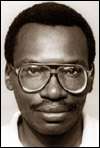Michael Werikhe
| Michael Werikhe | |
|---|---|
 | |
| Born |
25 May 1956 Mombasa, Kenya |
| Died |
9 August 1999 (aged 43) Mombasa |
| Other names | The Rhino Man |
| Occupation | Conservationist |
| Known for | Fundraising walks for the Black Rhinoceros |
Michael Werikhe (25 May 1956 – 9 August 1999), also known as “the Rhino Man” was a Kenyan conservationist. He became famous through his long fundraising walks in the African Great Lakes region and overseas. He started his campaign after learning how drastically Black Rhinos had decreased in Africa. Wherever he walked, his arrival was greeted with much public fanfare and media attention. This helped to raise funds for conservation of Rhinos and other endangered African mammals.
Activism
Werikhe first walk began on December 27, 1982. His walk from his hometown of Mombasa to Nairobi, lasted 27 days. In March 1985, he started his first international walk, from Kampala to Dar es Salaam, and eventually Mombasa, where he arrived on May 25.
Three years later in 1988, Werikhe started walking through several countries in Europe, including Italy, Switzerland, West Germany. His 3000 kilometres walk finished at the stairs of the Natural History Museum in London on September 14, 1988.
Werikhe also visited the United States in 1991, where he held a walk culminating at the San Diego Zoo.
He held two "Rhino walks" in 1993 in Taiwan, a notorious consumer nation of Rhino horns.
Although Werikhe typically walked alone, he often had co-walkers and guides with him.
His campaign was supported by Nehemiah Rotich (then chief of the East African Wildlife Society (EAWLS)), Richard Leakey, Juanita Carberry, Prince Philip and Prince Bernhard, among others.
Private life
Michael Sampson Werikhe was born 25 May 1956 in Mombasa. Son of Emanuel Werikhe. Michael spent his early life in Nairobi with his half-siblings Mary, Susan and David. Under the kind nurturing and guiding influence of Emanual Werikhe's British-born second wife, Sheila Margaret Werikhe (née Lewis), Michael's lifelong interest in conservation issues began.
By the age of 11 Michael had an extensive collection of rescued snakes, reptiles and chameleons living in pens at the family's two-bedroom flat in The Westlands residential area of Nairobi. He went to Secondary school at St.Georges High school,Giriama a catholic sponsored school in Mwabaya Nyundo Kaloleni. 1972-1975.Aged 19 Werikhe worked at Fort Jesus, Mombasa. Here he was given the task of cataloging the large store of illegally poached elephant ivory and Rhinoceros horn. It was the experience of witnessing tonnes of poached ivory and rhino horns that led Werikhe to begin his fund raising.
Werikhe believed the conservation solutions would only work with the active participation of local residents. Kenyans had always lived alongside the wildlife; the concept of killing animals for sport or poaching for profit are driven by influences beyond Kenya's borders. During the fund raising walk across the African Great Lakes region, Werikhe never carried money but relied on the goodwill of the ordinary Kenyans living in the bush to feed and shelter him. The rural population were Werikhe's initial target group. Rural people know what was happening within their local area and provide the first line of defence against poachers.
Werikhe died on 9 August 1999 after sustaining injuries in an assault near his home when leaving for work. He was a widower at the time of his death and left two daughters (Acacia and Kora). He was buried at Emmanuel Cemetery, Kisauni, Mombasa . The Michael Werikhe Trust was founded in his memory. In addition, the EAWLS donates an annual Michael Werikhe Award.[1]
Awards
Michael Werikhe won several awards, including global 500 award by UNEP.[2]
- Guinness Stout Effort Award (1983)
- David Sheldrick Memorial Award (1984)
- Boots Action Award (1985)
- EAWLS Conservation Award (1986)
- UNEP Global 500 Award (1989)
- Goldman Environmental Prize (1990)
- Eddie Bauer Heroes of Earth (1991)
- San Diego Zoological Society Conservation Medal (1991)
- African of the Millennium" award by BBC (1999) -posthumous
References
- Reader's Digest, October 1990 (Finnish edition)